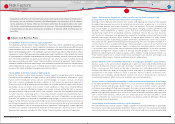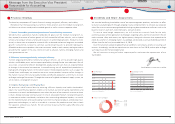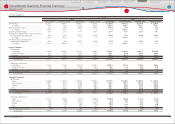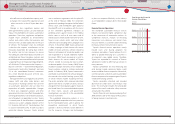Toyota 2010 Annual Report Download - page 29
Download and view the complete annual report
Please find page 29 of the 2010 Toyota annual report below. You can navigate through the pages in the report by either clicking on the pages listed below, or by using the keyword search tool below to find specific information within the annual report.
TOYOTA ANNUAL REPORT 2010 27
Toyota’s future success depends on its ability to offer new innovative competitively
priced products that meet customer demand on a timely basis
Meeting customer demand with attractive new vehicles and reducing the amount of time required
for product development are critical to automotive manufacturers. In particular, it is critical to
meet customer demand with respect to quality, safety and reliability. The timely introduction of
new vehicle models, at competitive prices, meeting rapidly changing customer preferences and
demands is more fundamental to Toyota’s success than ever, as the automotive market is rapidly
transforming in light of the weak global economic conditions. There is no assurance, however,
that Toyota will adequately and appropriately respond to changing customer preferences and
demands with respect to quality, safety, reliability, styling and other features in a timely manner.
Even if Toyota succeeds in perceiving customer preferences and demands, there is no assurance
that Toyota will be capable of developing and manufacturing new, price-competitive products in
a timely manner with its available technology, intellectual property, sources of raw materials and
parts and components, and production capacity, including cost reduction capacity. Further, there
is no assurance that Toyota will be able to implement capital expenditures at the level and times
planned by management. Toyota’s inability to develop and offer products that meet customers’
preferences and demands with respect to quality, safety, reliability, styling and other features in a
timely manner could result in a lower market share and reduced sales volumes and margins, and
may adversely affect Toyota’s financial condition and results of operations.
Toyota’s ability to market and distribute effectively is an integral part of Toyota’s successful sales
Toyota’s success in the sale of vehicles depends on its ability to market and distribute effectively
based on distribution networks and sales techniques tailored to the needs of its customers.
There is no assurance that Toyota will be able to develop sales techniques and distribution
networks that effectively adapt to changing customer preferences or changes in the regulatory
environment in the major markets in which it operates. Toyota’s inability to maintain well-
developed sales techniques and distribution networks may result in decreased sales and market
share and may adversely affect its financial condition and results of operations.
Toyota’s success is significantly impacted by its ability to maintain and develop its brand image
In the highly competitive automotive industry, it is critical to maintain and develop a brand image.
In order to maintain and develop a brand image, it is necessary to further increase customers’
condence by providing safe, high-quality products that meet customer preferences and demands.
If Toyota is unable to eectively maintain and develop its brand image as a result of its inability to
provide safe, high-quality products or as result of the failure to promptly implement safety measures
such as recalls when necessary, vehicle unit sales and/or sale prices may decrease, and as a result
revenues and profits may not increase as expected or may decrease, adversely aecting its nancial
condition and results of operations.
The worldwide financial services industry is highly competitive
The worldwide nancial services industry is highly competitive. Increased competition in automobile
nancing may lead to decreased margins. A decline in Toyota’s vehicle unit sales, an increase in residual
value risk due to lower used vehicle price, an increase in the ratio of credit losses and increased funding
Operational and other risks faced by Toyota that could significantly influence the decisions
of investors are set out below. However, the following does not encompass all risks related
to the operations of Toyota. There are risk factors other than those given below. Any such
risk factors could influence the decisions of investors. The forward-looking statements
included below are based on information available as of June 25, 2010, the filing date of
Form 20-F.
Industry and Business Risks
The worldwide automotive market is highly competitive
The worldwide automotive market is highly competitive. Toyota faces intense competition from automotive
manufacturers in the markets in which it operates. Competition has intensified amidst difficult overall
market conditions due to the weak global economy. In addition, competition is likely to further intensify in
light of continuing globalization in the worldwide automotive industry, possibly resulting in further industry
reorganization. Factors aecting competition include product quality and features, safety, reliability, the amount
of time required for innovation and development, pricing, fuel economy, customer service and financing
terms. Increased competition may lead to lower vehicle unit sales, which may result in a further downward
price pressure and adversely affect Toyota’s financial condition and results of operations. Toyota’s ability to
adequately respond to the recent rapid changes in the automotive market and to maintain its competitiveness
will be fundamental to its future success in existing and new markets and its market share. There can be no
assurances that Toyota will be able to compete successfully in the future.
The worldwide automotive industry is highly volatile
Each of the markets in which Toyota competes has been subject to considerable volatility in demand.
Demand for vehicles depends to a large extent on social, political and economic conditions in a given
market and the introduction of new vehicles and technologies. As Toyota’s revenues are derived
from sales in markets worldwide, economic conditions in such markets are particularly important to
Toyota. During scal 2010, despite government eorts to stimulate demand in Japan, North America
and Europe, which are Toyota’s main markets, market conditions in those areas remained difficult,
and Toyota was adversely aected by changes in the market structure with further shifts in consumer
demand to compact and low-priced vehicles. Such weakness in demand for automobiles and changes
in market structure is continuing, and it is unclear how long this situation would continue or how it
would transition in the future. Toyota’s nancial condition and results of operations may be adversely
affected if the weakness in demand for automobiles and changes in market structure continue or
progress further. Demand may also be aected by factors directly impacting vehicle price or the cost of
purchasing and operating vehicles such as sales and nancing incentives, prices of raw materials and
parts and components, cost of fuel and governmental regulations (including taris, import regulation
and other taxes). Volatility in demand may lead to lower vehicle unit sales, which may result in a further
downward price pressure and adversely aect Toyota’s financial condition and results of operations.
Risk Factors
Risk Factors
Corporate Information
Other Management and Corporate Data
Consolidated
Performance Highlights
Financial Section
Investor Information
Corporate Information
Business Overview
Special Feature
Top Messages
Corporate PhilosophyR&D and Intellectual Property Management Team Corporate Governance
























